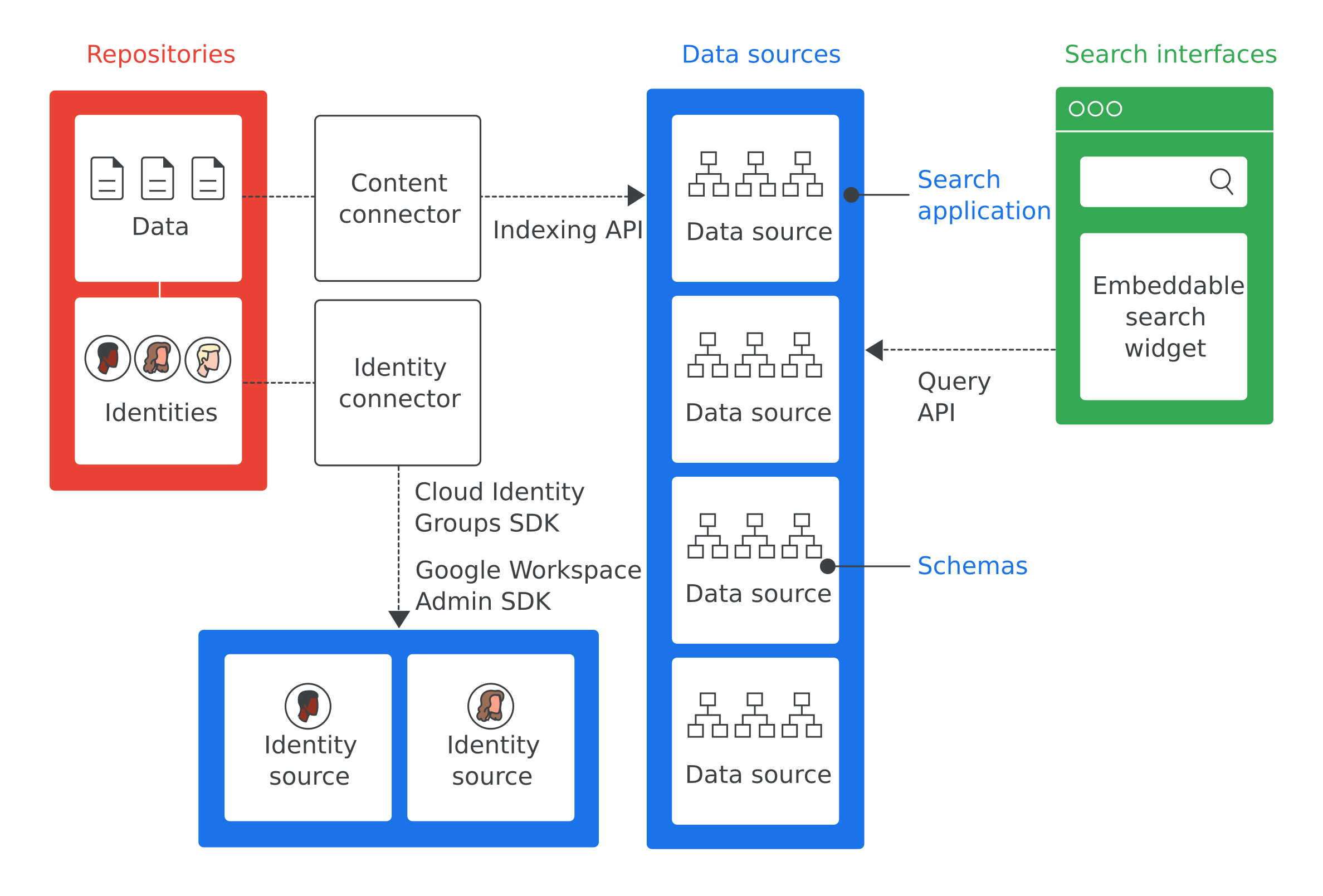Google Cloud Search به کارمندان یک شرکت اجازه می دهد تا اطلاعاتی مانند اسناد داخلی، فیلدهای پایگاه داده و داده های CRM را از مخازن داده های داخلی شرکت جستجو و بازیابی کنند.
نمای کلی معماری
شکل 1 تمام اجزای کلیدی پیاده سازی Google Cloud Search را نشان می دهد:

در اینجا تعاریف مهم ترین اصطلاحات از شکل 1 آورده شده است:
- مخزن
- نرم افزاری که توسط یک شرکت برای ذخیره داده های خود استفاده می شود، مانند پایگاه داده ای که برای ذخیره اطلاعات کارکنان استفاده می شود.
- منبع داده
- دادههای یک مخزن که در جستجوی ابری Google فهرست و ذخیره شده است.
- رابط جستجو
- رابط کاربری که توسط کارمندان برای جستجوی منبع داده استفاده می شود. یک رابط جستجو را می توان برای استفاده در هر دستگاهی، از تلفن همراه تا رایانه رومیزی، توسعه داد. ویجت جستجوی ارائه شده توسط Google نیز می تواند برای فعال کردن جستجو در وب سایت های داخلی شما مستقر شود. شناسه برنامه جستجو با هر جستجو همراه است تا اطمینان حاصل شود که زمینه آن جستجو، مانند ابزار خدمات مشتری، شناخته شده است. سایت cloudsearch.google.com دارای یک رابط جستجو است.
- برنامه جستجو
- گروهی از تنظیمات که در ارتباط با رابط جستجو، اطلاعات متنی در مورد جستجوها را ارائه می دهند. اطلاعات متنی شامل منابع داده و رتبه بندی جستجویی است که باید برای جستجو با استفاده از آن رابط استفاده شود. برنامههای جستجو همچنین مکانیسمهایی برای فیلتر کردن نتایج و فعال کردن گزارشدهی در منابع داده، مانند تعداد درخواستهای انجامشده در یک بازه زمانی معین، دارند.
- طرحواره
- ساختار داده ای که نشان می دهد چگونه داده ها در مخزن یک شرکت باید برای جستجوی ابری Google نمایش داده شوند. یک طرح واره، تجربه کارمند Google Cloud Search را تعریف میکند، مانند نحوه فیلتر کردن و نمایش چیزها.
- رابط محتوا
- یک برنامه نرم افزاری که برای پیمایش داده ها در مخزن یک سازمان و پر کردن یک منبع داده استفاده می شود.
- رابط هویت
- یک برنامه نرم افزاری که برای همگام سازی هویت های سازمانی (کاربران و گروه ها) با هویت های مورد نیاز جستجوی ابری Google استفاده می شود.
موارد استفاده Google Cloud Search
در اینجا چند مورد استفاده وجود دارد که ممکن است توسط Google Cloud Search حل شود:
- کارمندان به راهی برای یافتن خطمشیها، اسناد و محتوای شرکتی نیاز دارند که توسط سایر کارمندان نوشته شده است.
- اعضای تیم خدمات مشتری باید اسناد مربوط به عیب یابی را برای ارسال به مشتریان پیدا کنند.
- کارکنان باید اطلاعات داخلی در مورد پروژه های شرکت پیدا کنند.
- یک نماینده فروش می خواهد وضعیت تمام مسائل پشتیبانی را برای یک مشتری خاص مشاهده کند.
- کارکنان تعریفی برای یک اصطلاح خاص شرکت می خواهند.
اولین قدم در پیاده سازی Google Cloud Search، شناسایی موارد استفاده حل شده توسط Google Cloud Search است.
Google Cloud Search را پیاده سازی کنید
به طور پیشفرض، Google Cloud Search دادههای Google Workspace، مانند اسناد و صفحات گسترده Google را فهرستبندی میکند. نیازی به پیاده سازی Google Cloud Search برای داده های Google Workspace ندارید. با این حال، باید Google Cloud Search را برای دادههای غیر Google Workspace، مانند دادههای ذخیره شده در پایگاه داده شخص ثالث، سیستمهای فایل مانند Windows Fileshare، OneDrive یا پورتالهای اینترانت مانند Sharepoint پیادهسازی کنید. مراحل زیر برای پیاده سازی Google Cloud Search برای شرکت شما لازم است.
- یک مورد استفاده را تعیین کنید که Google Cloud Search به حل آن کمک می کند.
- مخازنی را که داده های مربوط به مورد استفاده را نگهداری می کنند، شناسایی کنید.
- سیستم های هویتی که توسط شرکت شما برای مدیریت دسترسی به داده ها در هر مخزن استفاده می شود را شناسایی کنید.
- دسترسی به Google Cloud Search API را پیکربندی کنید .
- یک منبع داده به Google Cloud Search اضافه کنید .
- برای هر منبع داده یک طرح واره ایجاد و ثبت کنید .
- تعیین کنید که آیا یک رابط محتوا برای مخزن شما موجود است یا خیر. برای فهرستی از رابطهای از پیش ساخته شده، به دایرکتوری رابط Cloud Search مراجعه کنید. اگر یک رابط محتوا در دسترس است، به مرحله 9 بروید.
- یک رابط محتوا برای دسترسی به دادههای موجود در هر مخزن ایجاد کنید و آن را در منبع داده Cloud Search فهرست کنید.
- تعیین کنید که آیا به یک رابط هویت نیاز دارید یا خیر. اگر به رابط هویتی نیاز ندارید، به مرحله 11 بروید.
- یک رابط هویت ایجاد کنید تا مخزن یا هویت سازمانی خود را با هویت های Google ترسیم کنید.
- برنامه های جستجو را تنظیم کنید .
- یک رابط جستجو برای انجام پرس و جوهای جستجو ایجاد کنید .
- رابطهای اتصال و جستجوی خود را مستقر کنید. اگر از کانکتور از پیش ساخته شده استفاده میکنید، دستورالعملهای کانکتور را دنبال کنید تا کانکتور را بهدست آورید و راهاندازی کنید. رابطهای موجود در فهرست راهنمای Google Cloud Search Connector فهرست شدهاند
مراحل بعدی
در اینجا چند مرحله بعدی وجود دارد که ممکن است بردارید:
- آموزش شروع Google Cloud Search را امتحان کنید.
- موارد استفاده را که برای آنها از جستجوی ابری Google استفاده خواهید کرد، تعیین کنید.
- مخازن مربوط به این موارد استفاده را شناسایی کنید.
- هر سیستم هویتی مورد استفاده توسط مخازن شما را شناسایی کنید.
- پیکربندی دسترسی به Google Cloud Search API را ادامه دهید.
